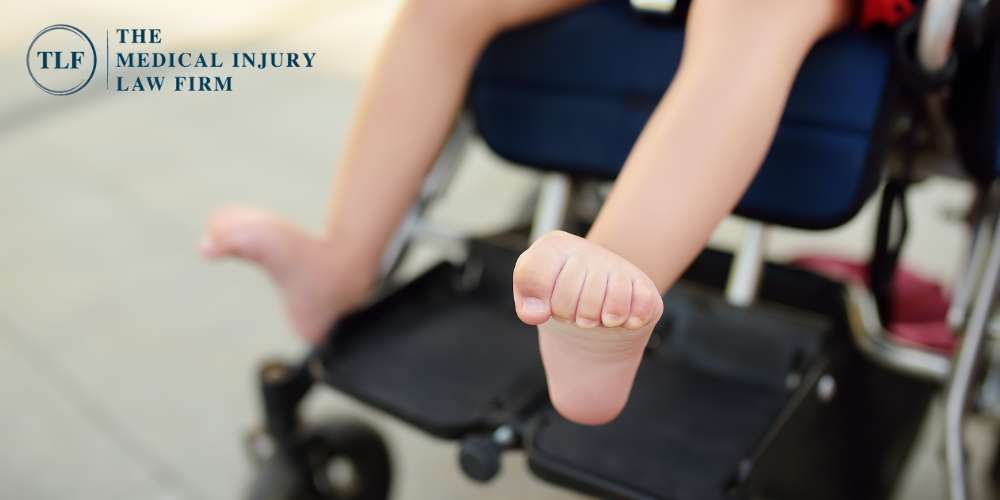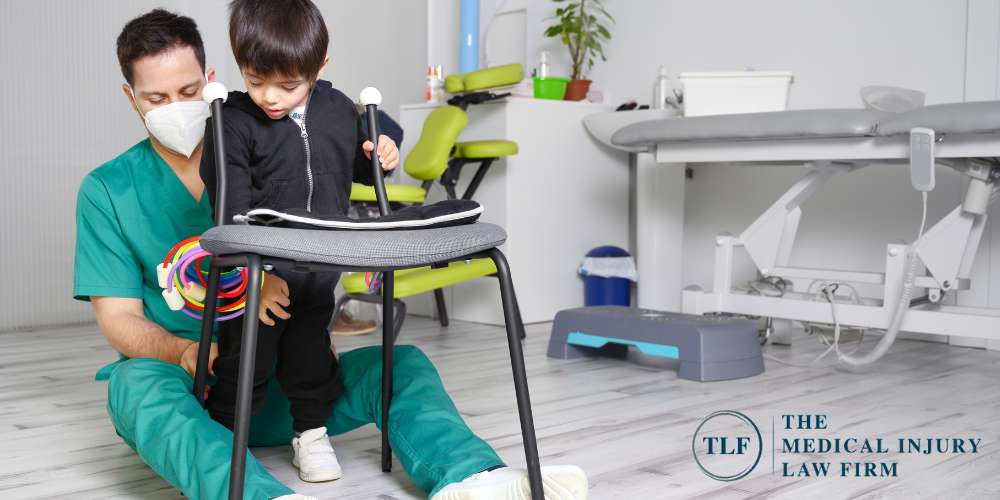Putting Our Knowledge And Experience To Work
Home » Birth Injuries » Spastic Hemiplegia
Spastic Hemiplegia
Northern Kentucky and Ohio Birth Injury Attorneys for Spastic Hemiplegic Cerebral Palsy
Spastic hemiplegia is a neurological condition that often stems from birth injuries like cerebral palsy, and can lead to challenges with development, movement, coordination, and fine motor skills. This kind of condition can hinder a child’s ability to perform daily activities and participate fully in school, social, and recreational activities.
If your child has been diagnosed with spastic hemiplegia and you suspect that medical negligence may have played a role, call one of our Ohio or Kentucky cerebral palsy lawyers at TLF: The Medical Injury Law Firm today. Our attorneys have extensive experience handling complex medical malpractice cases like these and will work tirelessly to help you recover full and fair compensation on behalf of your child.

We’re proud to serve the residents of Northern Kentucky and Ohio, providing representation to individuals and families who have suffered from various acts of medical negligence. Ready to take the first step toward receiving justice? Call our law firm toll-free at (800) 698-4054 or reach out online today to schedule a free consultation with an experienced medical malpractice attorney on our team.
What is Hemiplegia?
Hemiplegia refers to a condition in which someone experiences paralysis or weakness on one side of the body. This affects movement of the face, neck, arms, hands, legs, and feet on one side of the person’s body, which can lead to difficulty participating in a variety of activities, including everything from walking, getting dressed, using the toilet, and even grabbing objects.
What is Spastic Hemiplegia?
Spastic hemiplegia, also sometimes referred to as spastic CP, is a subtype of cerebral palsy characterized by muscle stiffness and tightness on one side of the body. There are a few other subtypes of cerebral palsy that involve muscle spasticity, including spastic diplegia and spastic quadriplegia.
Spastic Diplegia
Spastic diplegia is a form of cerebral palsy that affects the legs and lower body, causing both legs to suffer from muscle weakness and stiffness, as well as higher muscle tone in the legs.
Spastic Quadriplegia
Spastic quadriplegia is a severe form of cerebral palsy where the person experiences muscle stiffness and weakness in all four limbs, as well as the trunk and face.

Signs and Symptoms of Spastic Hemiplegic Cerebral Palsy
As previously mentioned, the most common signs and symptoms of spastic hemiplegic cerebral palsy include muscle weakness, abnormal gait, and stiffness on one side of the body. More specifically, children with this condition may exhibit a tendency to favor one hand over the other and may exhibit asymmetrical crawling or walking patterns. They may also experience challenges with fine motor skills, such as grasping objects with their affected arm.
Other symptoms of spastic hemiplegia include involuntary movements and difficulty meeting certain developmental milestones on the affected side.
What Causes Spastic Cerebral Palsy?
Spastic cerebral palsy is typically caused by brain damage that occurs before, during, or shortly after birth. The exact cause of this damage can vary, but it often involves disruptions to the developing brain’s motor cortex, or the part of the brain controlling movement.
Risk factors for spastic cerebral palsy include prenatal, perinatal, and postnatal factors such as:
- Infections during pregnancy
- Exposure to toxins or drugs
- Abnormal brain development
- Traumatic brain injury
- Spinal cord injury
- Premature birth
- Fetal distress
- Oxygen deprivation, including hypoxia-ischemia or birth asphyxia
- Umbilical cord problems, including umbilical cord compression
- Head trauma
The causes of birth injuries can vary widely, but they are often the result of medical negligence during pregnancy, labor, or delivery. If your child has suffered from spastic hemiplegia as a result of medical negligence, contact a Northern Kentucky or Ohio medical malpractice attorney at TLF: The Medical Injury Law Firm as soon as possible.

Diagnosis and Treatment for Hemiplegia
Spastic hemiplegia cerebral palsy is typically diagnosed through a combination of medical history, physical examination, and neuroimaging studies such as MRI or CT scans. These can assess the child’s movement, developmental abilities, and reflexes, as well as their brain structure and function.
Oftentimes, spastic hemiplegia is treated using a multidisciplinary approach, providing the patient with the resources needed to improve fine motor skills, movement, and development. Some treatments include physical therapy, occupational therapy, speech therapy, and constraint-induced movement therapy (CIMT).
One of the most effective treatments for reducing spasticity is through therapeutic exercises that help with neuroplasticity, which refers to the brain’s ability to rewire itself. Exercises like CIMT and other targeted exercises work to activate new neural pathways in the brain, helping individuals with cerebral palsy (as well as those who suffer a stroke, traumatic brain injury, and spinal cord injury) retrain their brain to complete daily tasks and make permanent improvements in the movements of their affected limbs.
Additionally, medications such as muscle relaxants or botulinum toxin (Botox) injections may be used to manage spasticity, and certain assistive devices may be recommended to support mobility and function. In some cases, surgical interventions such as selective dorsal rhizotomy or orthopedic procedures may be considered to alleviate spasticity or improve mobility.

What are the Long-Term Effects of Spastic Hemiplegia?
Spastic hemiplegia is a lifelong condition with no known cure, so patients with spastic hemiplegia often require long-term treatment for their symptoms. Young children who suffer from spastic hemiplegia often experience early childhood issues when it comes to things like crawling and grasping objects and will continue to experience difficulties with movement and coordination throughout their lifetime.
In addition to the physical effects of spastic hemiplegia, children with this condition often face emotional distress as a result of their condition. They may face difficulties in social situations due to physical differences or limitations, and may also experience frustration or feelings of inadequacy when they cannot perform tasks as easily as their peers.
The families of children with spastic hemiplegia may face unique challenges as well. Caring for a child with complex medical and developmental needs can be emotionally and physically demanding, requiring significant time, energy, and financial resources. Families often need to navigate the healthcare system on a regular basis, coordinate various therapies and interventions, and advocate for their children’s needs within educational and community settings.
However, despite these challenges, children with spastic hemiplegia can lead fulfilling and meaningful lives when provided with the appropriate support and interventions.
Why Early Detection is So Important
It’s important that spastic hemiplegia is detected, diagnosed, and treated as soon as possible to ensure the best possible outcomes for the child and to help mitigate the potential effects of the condition as well as prevent any further complications.
In the context of spastic hemiplegia, early detection means early treatment options, which can capitalize on a child’s neuroplasticity and promote optimal brain development, even in the face of a brain injury. While early detection can’t cure spastic hemiplegia, it can improve the child’s motor control, coordination, and functional abilities, providing the child with improved developmental possibilities.
Under the Individuals with Disabilities Education Act (IDEA), newborns and young children with spastic hemiplegia can receive early medical interventions for their condition. By starting interventions early, potential complications and secondary impairments can be minimized, promoting better functional abilities and enhancing the child’s overall quality of life.

When Medical Negligence is Involved
Labor and delivery malpractice may occur when medical professionals fail to provide the minimum standard of care that is expected of them, which can cause mothers and unborn or newborn children to suffer from serious birth injuries. Sometimes, these injuries can lead to developmental disabilities and movement disorders like spastic hemiplegia cerebral palsy.
Parents of children who suffer from spastic hemiplegia as a result of medical malpractice can pursue legal action to seek damages on behalf of their child. This process typically involves filing a medical malpractice lawsuit against the healthcare providers or facilities responsible for the negligence.
Through a malpractice lawsuit, birth injury victims can seek compensation for their losses, including medical bills, lost wages, ongoing care needs, assistive technology costs, loss of enjoyment of life, loss of future earning capacity, and more.
To succeed in such lawsuits, parents must establish that the healthcare providers failed to provide the standard of care that was expected of them, and this breach of medical duty directly caused their child’s injuries. Expert medical testimony and thorough investigation are often necessary to support these claims and secure fair compensation for the child’s injuries and losses.
TLF Helps Birth Injury Victims Recover Maximum Compensation
Proving medical negligence can be extremely difficult, which is why victims of medical malpractice can benefit significantly by seeking legal counsel from an experienced Kentucky or Ohio birth injury attorney like those at TLF: The Medical Injury Law Firm. At TLF, we are dedicated to holding negligent medical professionals accountable and helping birth injury victims across Ohio and Northern Kentucky recover maximum compensation for their losses.
Our experienced attorneys work diligently to investigate the details of each case we take on, consulting with medical experts to assess and establish liability. We utilize our vast legal knowledge, years of experience, and resources to build strong cases for our clients and advocate for their rights at every turn, providing them with the legal support they need during this difficult time.
At TLF, we understand the profound impact that birth injuries such as spastic hemiplegia can have on families, which is why we are committed to securing compensation for all medical expenses, ongoing care needs, rehabilitation therapies, and other damages. Rest assured, we will strive to achieve justice and financial security for birth injury victims and their families.

Northern Kentucky and Ohio Medical Malpractice Attorneys for Spastic Hemiplegia Birth Injuries
At TLF: The Medical Injury Law Firm, we understand how devastating spastic hemiplegia birth injuries can be for children and their families, often leading to severe, long-term consequences. That’s why our experienced medical malpractice attorneys are dedicated to providing compassionate and comprehensive legal representation to victims of medical negligence.
Our goal is to hold negligent healthcare providers accountable for their actions and to ensure that our clients receive the full and fair compensation they need to cover medical expenses, ongoing care needs, rehabilitation therapies, and other damages. If your family has been affected by spastic hemiplegia birth injuries due to medical malpractice, don’t hesitate to reach out to TLF for help right away.
We’re proud to serve Ohio and Kentucky. To get in touch, call our Cincinnati law office at (513) 651-4130, our Covington law office at (859) 578-9130, or toll-free at (800) 698-4054. You can also contact us online to schedule a free consultation with an experienced attorney on our team today.
Practice Areas
You Pay No Fees Unless We Win!
We are happy to offer a free consultation to evaluate your case. If you hire us as your legal counsel, we will represent you on a contingency-fee basis. You will pay no attorneys’ fees unless we recover financial damages.
